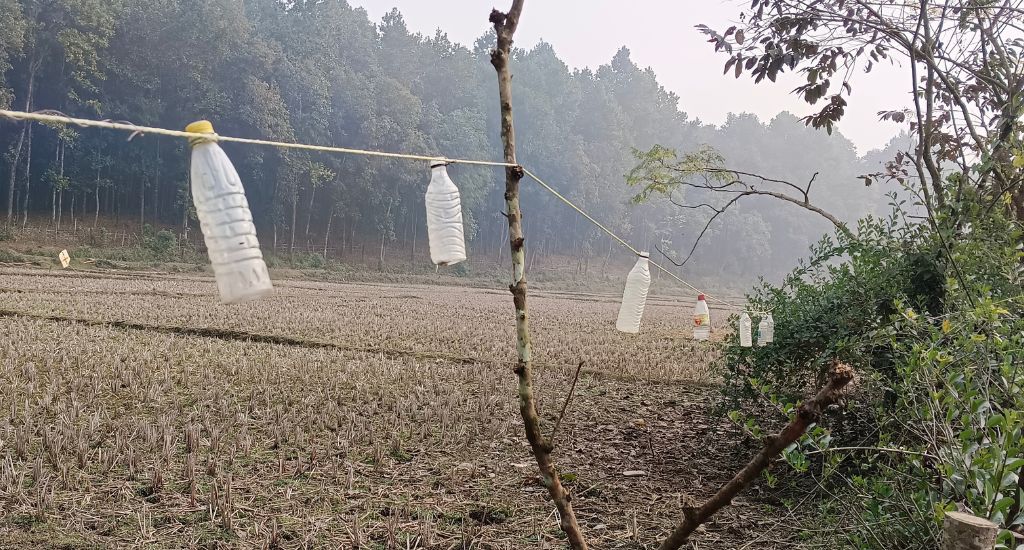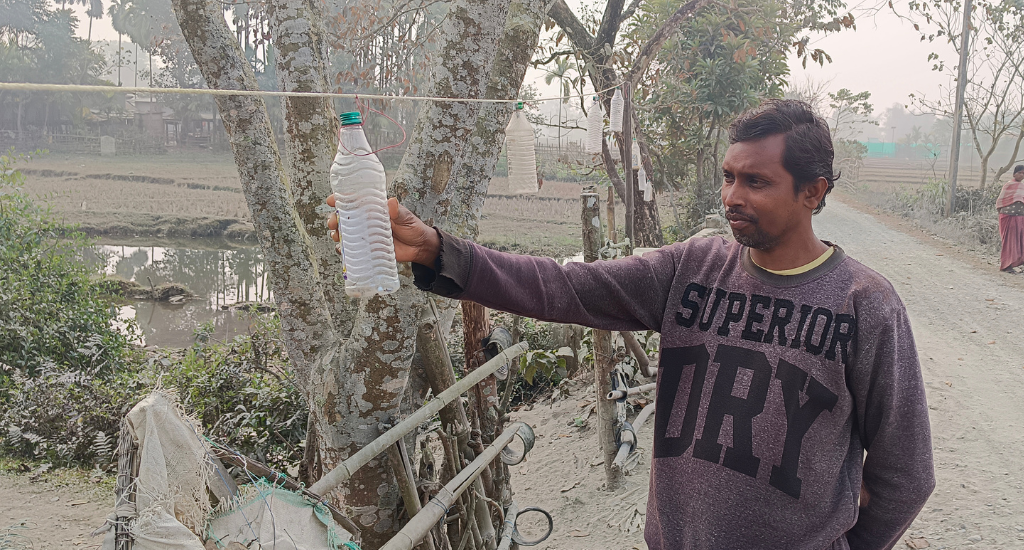
Novel elephant alarm: Bengal villagers turn to the bottle
Bengal farmers create an innovative method to save their paddy crops and prevent conflict between humans and rampaging elephants in a West Bengal village in the Jalpaiguri district.

Bengal farmers create an innovative method to save their paddy crops and prevent conflict between humans and rampaging elephants in a West Bengal village in the Jalpaiguri district.
People retreat inside as the gathering darkness brings in its wake a jumbo-sized fear in the West Bengal village that acts as a buffer zone to the protected Khuntimari Moraghat forest in the Jalpaiguri district.
But hard-working farmer Sukhram Oraon sleeps tight at night in his tin-roofed house made of mud and wood, occasionally awakened by an alarm he designed and installed around his farmstead three years ago.
It goes off like baby rattles – a racket of dozens of them together – to tell him of a raiding party of elephants from the forest.
Like many ingenious ideas, Oraon’s alarm is rooted in simplicity.

He takes empty plastic bottles of local liquor, fills them with small stones, and strings them a little apart on a nylon rope that he ties to trees and posts at belly level for the elephants to create a fence.
When the elephants try to enter, they push at the ropes and shake the bottles, causing the stones to clatter and wake up Oraon.
Also Read | The elephant and the honey bee: Are there lessons for Meghalaya and Tripura?
“The elephants come out at night. They come all the way up to the house. When the alarm bursts forth, I light a fire torch and set off firecrackers to scare them away. They retreat,” said Oraon, 38, recalling the horrors.
The message in the bottle was loud and clear.
Located 700km north of Kolkata, the village of 60 households and around 300 hardy, farming people has taken a shine to it.
Elephants are the largest land animals in India and can weigh up to five tonnes, but the giants have the unique ability to walk as quietly as a mouse, making it absolutely impossible to hear and see them moving about after dark. Unless they make a trunk call.
Villagers living on the fringes of wildlife parks often find themselves in a hostile situation with wandering elephants.

Elephants are increasingly coming into contact with people in India, as the human population of 1.3 billion soars and cities and towns grow at the expense of jungles and other elephant habitats.
To stop wild elephants from rampaging through their produce and property, farmers have put up electric fences, burst firecrackers and even switched to crops that pachyderms don’t relish much.
None of it really worked.
So Oraon turned to Plan B – “b” for bottle – a gentle but effective way of alarming people. His method does not get the elephants stoned but ensures people know when the lumbering giants hit the bottle.
“I didn’t want to put an electric fence around the field because that’s cruel for the animals. I was looking for something to save my crops and home without harming the elephants,” he said.
Also Read | Throw mustard in the elephant’s face
His alarm system is a spinoff of fellow villager Jatra Rabha’s idea of hanging empty tin drums to a rope in his field after elephants completely destroyed the 62-year-old’s two bighas of paddy crop in 2018.
“We were sleeping when they attacked the field. My entire paddy crop was gone in one night,” Rabha said.
The villagers have been using stakeout and surveillance to monitor elephants on their nightly runs.

“We’ve built machans (watch towers) on trees and stilts, but it’s dangerous. They attack humans,” said panchayat member Dayud Rabha.
Forest officials have praised the villagers, although many farmers accused the department of failing to do its duty and leaving them to fend for themselves.
“It’s an innovative move to prevent their fields from getting damaged and also saving the lives of elephants. Many farmers are using bottle alarms, drawing inspiration from this village,” said Sima Choudhury, the wildlife warden of Jalpaiguri Gorumara division.
The fight against elephants is like squeezing a balloon – when gains are made in one area, conflicts intensify in another spot. The encroachment of human settlements is reducing the animals’ range, forcing them out of their natural habitats and triggering conflicts with locals.
Elephants destroy crops and sometimes kill people. Research showed Bengal has 2% of India’s elephant population, but has the highest human casualties in almost a decade from 2010.
The study revealed staggering numbers from this man-elephant conflict: 726 human fatalities, 1,233 injuries, over 51,000 hectares of crop loss, 34,446 houses damaged, as opposed to 136 unnatural elephant deaths in Bengal from April 2010 to March 2019. Elephants are also threatened by speeding trains and illegal poachers looking for ivory to sell on the black market.

“Electrocution was the leading cause of elephant deaths, followed by train accidents and poaching. The rise in both human and elephant population is causing conflicts. The elephants have a fixed migration route, but human settlements have come up in those routes,” said researcher Dr Rajib Majumder, who teaches zoology at Vivekananda Mahavidyalaya in Haripal.
Also Read | Pepper helps Rabhas to live with tuskers
Elephants travel in a big herd, razing everything to the ground everywhere they go. They come out at night, sometimes all the way up to people’s houses, banged against doors and windows.
Conservationists have urged the government to prevent encroachments and free the land corridors that are used by elephants as they move across forests in search of food.
The lead image at the top shows used plastic bottles filled with small stone chips attached them to a branch (Photo by Gurvinder Singh)
Gurvinder Singh is a journalist based in Kolkata.